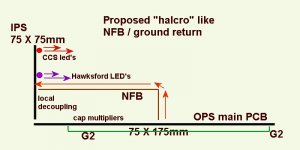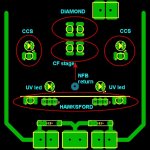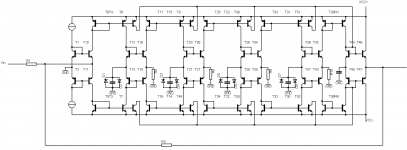Trouble is ... sometimes being 'anal' is exactly what's required to solve a problem - everything else one does is skirting the issue, like trying to move a stone by pushing it with a stick that's 10 feet long - sometimes, the best solution is to just get in there and move the bloody stone by picking it up in your bare hands!! ... 😀
It's interesting how, just a few years ago, everyone was in awe on this forum about sub ppm distortion - I recall a discussion about it and BC's comment (in a magazine article) that if one were to look at the Halcro circuit you'd struggle to recognize it as an amplifier.
As a design community, we achieve these performance levels - and better IMV- routinely here on DIYAudio firstly in the Lin 'blameless' topology, and then later in fully balanced designs, and more recently in CFA.
On this specific thread, I think there has been tremendous progress in taking CFA forward and proving its suitability for high performance audio - it has opened up a whole new avenue for designers to explore.
😎
NX-"H" pcb
Now the fun part - I LOVE laying out IPS's ! 🙂
Think of the IPS like a BIG op-amp ... same rules.
Local decoupling close to the active "players" , like the Vcc/Vee
on a chip.
Trace wise , I'm only 25-30mm away from my multipliers .... but
one can't be too careful !
🙂
OS
Now the fun part - I LOVE laying out IPS's ! 🙂
Think of the IPS like a BIG op-amp ... same rules.
Local decoupling close to the active "players" , like the Vcc/Vee
on a chip.
Trace wise , I'm only 25-30mm away from my multipliers .... but
one can't be too careful !
🙂
OS
Attachments
😎🙂
Hmmmm. Well, I suggested only two in cascade. This is OTTop. What does a Mr. SIM think of this? What does fewer stages do this way?
Thank you for trying to find out what can be obtained by cascading current mirrors.
Thx-RNMarsh
No idea. By the way, attached is a variant with zeroes made by feed-forward, which might give you less phaseshift. You are probably right about it being over the top; I could imagine that for all variants with distortion in the order of 1 ppm magnetic coupling is going to set the performance anyway, in which case adding stages won't do anything anymore.
Attachments
No idea. By the way, attached is a variant with zeroes made by feed-forward, which might give you less phaseshift. You are probably right about it being over the top; I could imagine that for all variants with distortion in the order of 1 ppm magnetic coupling is going to set the performance anyway, in which case adding stages won't do anything anymore.
Well, it looks like great fun ! Should be pretty interesting performance 🙂
-Richard Marsh
I cannot let this unanswered.Like CD is still getting kicked by analoge, like streaming (even High def) still has years left to actually musically compete with CD, then digital amplifiers also need years of refinement to really be a serious contender.
It goes against all what i'm sure of.
It is like comparing painting and digital photography...
You can love analog recordings, or vinyls for the kind of atmosphere it produce, but one thing is for sure, it is everything but fidelity. Noisy, colored, distorted. Sound changing from a playing hardware to an an other...
Even numbers and measurements will show-it indubitably.
More than that, even at the early beginnings of digital recording, the most critical part was the analog part of the DA converters. (my first tries with current feedback OPAs)
Just listen to one of the first digital album ever made, "Bop Till you drop" by Ry Cooder.
In a good recording studio, i will always be able to discriminate in a second a before/after analog tape. While unable to do the same with a digital recorder.
Not to talk about vinyls or magnetic tapes, and the way they are self destroyed by the time...
But we are so far from CFAs, that i will forget for ever as soon i will find a 200W digital 24bits 48Khz power DA converter...
I believe it's not due to numbers, but the fact that in analog the signal starts as the inverse of what happens in the speakers, it starts and ends as vibration in coils. This coding/decoding of the signal just takes you a step closer to the intent.
It's in the timing, I sense the biggest difference. I agree it's a bummer that the media is not so resilient or has more noise. But that not really the point when it comes to conveying the emotions of the recording.
It's in the timing, I sense the biggest difference. I agree it's a bummer that the media is not so resilient or has more noise. But that not really the point when it comes to conveying the emotions of the recording.
I wonder how it would be possible to make a Balanced input on the Diamond Front-end..??
Would that be possible and still maintain the CFA feedback in the second stage..??
Would that be possible and still maintain the CFA feedback in the second stage..??
It's interesting how, just a few years ago, everyone was in awe on this forum about sub ppm distortion
It is also interesting how, just a few years ago, CFAs were demonized for audio applications.
In all truth, the only thing you succeeded with this thread is perhaps a new fashion. I still haven't seen any non anectodic proof that what you call a "CFA" has any advantage over a standard and well designed Lin topology.
I don't think any sane engineer ever bought in the CFA hate and awe campaigns, anyway. BTW, who said CFAs can't be very low distortions? I'm looking at the TI data sheets and I see single digit ppm in the MHz range.
In all truth, the only thing you succeeded with this thread is perhaps a new fashion.
Maybe unfair to call it fashion. I prefer to think of CFA as an alternative to LTPs. LTPs appear to be pretty much developed to death and instead of designing something yourself, you might as well copy someone else's.
Maybe unfair to call it fashion. I prefer to think of CFA as an alternative to LTPs. LTPs appear to be pretty much developed to death and instead of designing something yourself, you might as well copy someone else's.
I would agree with you, if you'd replace in the above "CFA" with "diamond buffer".
I would agree with you, if you'd replace in the above "CFA" with "diamond buffer".
Ok, I'll agree with the change. Wrongly, in my mind, I've made "CFA" interchangeable with diamond buffer (and its close relative that appears in this thread).
Member
Joined 2009
Paid Member
I don't limit my use of the expression 'CFA' to DB's, but include the Singleton input. This type of input has been well used around here. It seems to me that the 'fashion' of this thread is as much about symmetrical designs as it is about 'CFA'.
There's no fashion in this thread.
CFA is a viable alternative topology to VFA.
Apply the two tests!
CFA is a viable alternative topology to VFA.
Apply the two tests!
CFA is a viable alternative topology to VFA.

My prototypes, at least to my ears, confirm this.
And more than 2 or 3 decades of correlated experiences on my side, too 🙂
My prototypes, at least to my ears, confirm this.
Member
Joined 2009
Paid Member
Let me put it another way, 'CFA' has become fashionable and partly because of this thread. Although many of us have been using it for years !
However, I don't ascribe to strict definitions for the term, it's a term that has been abused somewhat - but you can do what you like in your own home if it makes you happy 😀
However, I don't ascribe to strict definitions for the term, it's a term that has been abused somewhat - but you can do what you like in your own home if it makes you happy 😀
However, I don't ascribe to strict definitions for the term, it's a term that has been abused somewhat - but you can do what you like in your own home if it makes you happy 😀
Language is a tool for communication and can and does evolve. 🙂
I have been unknowingly listening to "CFA" (Diamond Buffer)and VFA (LTP) for years in commercial amps. Had examples of good and bad of both. Now I have kept two amps and by chance one is a "VFA" (LTP) and the other is a "CFA" (Diamond Buffer).
Edited for Waly 😉
Last edited:
There's no fashion in this thread.
CFA is a viable alternative topology to VFA. They are essentially marketing catch phrases.
Apply the two tests!
Your tests were already proved technically wrong.
I agree that the diamond buffer can be an alternative to the LTP input stage, with pros and cons, as usual.
You failed to explain why a couple of years ago the same subjective crowd was boooing any attempt to introduce the CFA in audio, while today is marketed as the holy grail.
- Home
- Amplifiers
- Solid State
- CFA Topology Audio Amplifiers
 .
.

